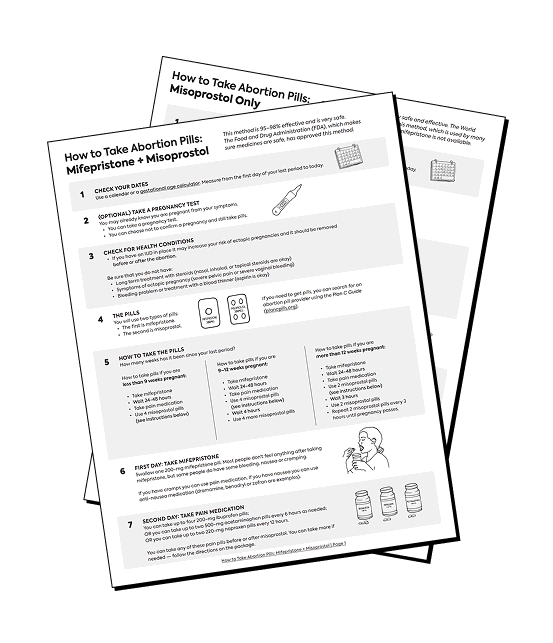
How to take abortion pills: step by step instructions
Source: Reproductive Health Access Project & M+A Hotline
A note that this is not medical or legal advice.
There are two methods for using abortion pills to help stop a pregnancy. Both work well and are widely used worldwide. The World Health Organization calls them "essential medicines," and research shows pills are safe for both in-clinic and home use.
A note that different providers may use slightly different versions of the protocol.
Method 1: Mifepristone & misoprostol
This method is 95% - 98% effective and is very safe. The Food and Drug Administration (FDA), which makes sure medicines are safe, has approved this method.
1Check your dates

Use a calendar or a gestational age calculator. Measure from the first day of your last period to today.
2(Optional) Take a pregnancy test

You may already know you are pregnant from your symptoms.
- You can take a pregnancy test.
- You can choose not to confirm a pregnancy and still take pills.
3Check for health conditions
- If you have an IUD in place it may increase your risk of ectopic pregnancies and it should be removed before or after the abortion.
Be sure that you do not have:
- Long term treatment with steroids (nasal, inhaled, or topical steroids are ok)
- Symptoms of ectopic pregnancy (severe tummy pain or severe vaginal bleeding)
- Bleeding problem or treatment with a blood thinner (aspirin is ok)
4The pills

You will use two types of pills:
- The first is mifepristone.
- The second is misoprostol.
You can learn about abortion pill provider options in the Plan C Guide.
5How to take the pills
How to take pills if you are less than 9 weeks pregnant:
- Take mifepristone
Wait 24-48 hours
- Take pain medication
- Use 4 misoprostol pills (see instructions below)
How to take pills if you are 9-12 weeks pregnant:
- Take mifepristone
Wait 24-48 hours
- Take pain medication
- Use 4 misoprostol pills (see instructions below)
- Wait 4 hours
- Use 4 more misoprostol pills
How to take pills if you are more than 12 weeks pregnant:
- Take mifepristone
Wait 24-48 hours
- Take pain medication
- Use 2 misoprostol pills (see instructions below)
- Wait 3 hours
- Use 2 misoprostol pills
- Repeat 2 misoprostol pills every 3 hours until pregnancy passes.
6First day: Take mifepristone

Swallow one 200-mg pill. Most people don't feel anything after taking mifepristone, but some people do have some bleeding, nausea or cramping.
If you have cramps you can use pain medication. If you have nausea you can use anti-nausea medication (dramamine, benadryl or zofran are examples).
7Second day: Take pain medication

- You can take up to four 200-mg ibuprofen pills;
- OR you can take up to two 500-mg acetaminophen pills every 6 hours as needed;
- OR you can take up to two 220-mg naproxen pills every 12 hours.
You can take any of these pain pills before or after misoprostol. You can take more if needed - follow the directions on the package.
8Use misoprostol

Use the list in Step 5 to find how many misoprostol pills to take and when to take them.
There are three ways to take misoprostol pills. You can put pills inside your cheeks, under your tongue, or in your vagina. Choose the method that feels best to you. Do this between 24-48 hours after swallowing mifepristone.
- For Mouth: Put pills inside each cheek or under your tongue. Hold them there for 30 minutes while your body absorbs the medicine. It's ok to swallow your saliva. Then swallow the pills with a drink.
- For Vagina: Put pills in your vagina. Lie down for 30 minutes as your body absorbs the medicine. If the pills fall out after 30 minutes, throw them away or flush them.
People concerned with keeping their healthcare private usually put the misoprostol pills inside their cheeks or under the tongue. When misoprostol is inserted into the vagina, there is a chance undissolved pills could be detected during a medical exam.
9Side effects

Cramps and heavy bleeding should start within 24 hours after misoprostol.
- If you have no cramps and bleeding after 4-6 hours, you can use 2 more misoprostol pills.
- You may see blood clots.
- You may have diarrhea, fever, or chills.
- If you use misoprostol in the mouth, it can make your tongue sore. Misoprostol can also cause nausea, vomiting, diarrhea, fever, chills, shaking - that is normal and should get better within 24 hours.
- If you have nausea you can use anti-nausea medication (benadryl, dramamine or zofran are examples).
If you're more than 8-9 weeks, you may see fetal remains and wonder what to do with them. You can contact Reprocare for peer support or the M+A Hotline for clinician support. The ReproLegal Helpline can help you understand your legal risks. This is important because some people have gotten in trouble for what they did with fetal remains.
10How much bleeding is too much?

If you soak through 2 large overnight pads per hour, for 2 hours in a row, you should contact a clinician.
You can always call or text the M+A Hotline for free, confidential medical support.
11After the abortion

The heavy bleeding should slow down within 24 hours. You might bleed on-and-off for a few weeks after the abortion.
Contact your provider if:
- you don't bleed after using misoprostol
- you still have heavy bleeding a few days after the abortion
- you still feel pregnant
Your pregnancy symptoms should go away after you use the pills. Pregnancy tests can stay positive 5 weeks after the abortion. If you're not sure if the abortion worked, you can get an ultrasound. You can have sex again when you feel ready.
You can get pregnant again as soon as 8 days after an abortion. Most birth control methods can be started right after an abortion.
Important: If you had an abortion after 12 weeks and your blood type is rH negative (A-, B-, O-, AB-), you should get a shot called Rhogam. This prevents problems in future pregnancies. You should get the shot within 2 days of the abortion.
Method 2: Misoprostol only
This method is also very safe and effective. The World Health Organization supports this method, which is used by many people around the world where mifepristone is not available.
1Check your dates

Use a calendar or a gestational age calculator. Measure from the first day of your last period to today.
2(Optional) Take a pregnancy test

You may already know you are pregnant from your symptoms.
- You can take a pregnancy test.
- You can choose not to confirm a pregnancy and still take pills.
3Check for health conditions
- If you have an IUD in place it may increase your risk of ectopic pregnancies and it should be removed before or after the abortion.
Be sure that you do not have:
- Long term treatment with steroids (nasal, inhaled, or topical steroids are ok)
- Symptoms of ectopic pregnancy (severe tummy pain or severe vaginal bleeding)
- Bleeding problem or treatment with a blood thinner (aspirin is ok)
4The pills

You need 12-16 misoprostol pills. Each one is 200mcg.
You can learn about abortion pill provider options in the Plan C Guide.
5How to take misoprostol
How to take pills if you are less than 12 weeks pregnant:
- Use 4 misoprostol pills every 3 hours (12 pills total, see instructions below).
- If no bleeding occurs after the 3rd time, you can use 4 more misoprostol pills 3 hours later.
How to take pills if you are more than 12 weeks pregnant:
- Use 2 misoprostol pills every 3 hours until the pregnancy passes (see instructions below)
6Take pain medication

- You can take up to four 200-mg ibuprofen pills;
- OR you can take up to two 500-mg acetaminophen pills every 6 hours as needed;
- OR you can take up to two 220-mg naproxen pills every 12 hours.
You can take any of these pain pills before or after misoprostol. You can take more if needed - follow the directions on the package.
7Use misoprostol

Use the list in Step 5 to find how many misoprostol pills to take and when to take them.
There are three ways to take misoprostol pills. You can put pills inside your cheeks, under your tongue, or in your vagina. Choose the method that feels best to you. Do this between 24-48 hours after swallowing mifepristone.
- For Mouth: Put pills inside each cheek or under your tongue. Hold them there for 30 minutes while your body absorbs the medicine. It's ok to swallow your saliva. Then swallow the pills with a drink.
- For Vagina: Put pills in your vagina. Lie down for 30 minutes as your body absorbs the medicine. If the pills fall out after 30 minutes, throw them away or flush them.
People concerned with keeping their healthcare private usually put the misoprostol pills inside their cheeks or under the tongue. When misoprostol is inserted into the vagina, there is a chance undissolved pills could be detected during a medical exam.
8Side effects

Cramps and heavy bleeding should start within 24 hours after misoprostol.
- If you have no cramps and bleeding after 4-6 hours, you can use 2 more misoprostol pills.
- You may see blood clots.
- You may have diarrhea, fever, or chills.
- If you use misoprostol in the mouth, it can make your tongue sore. Misoprostol can also cause nausea, vomiting, diarrhea, fever, chills, shaking - that is normal and should get better within 24 hours.
- If you have nausea you can use anti-nausea medication (benadryl, dramamine or zofran are examples).
If you're more than 8-9 weeks, you may see fetal remains and wonder what to do with them. You can contact Reprocare for peer support or the M+A Hotline for clinician support. The ReproLegal Helpline can help you understand your legal risks. This is important because some people have gotten in trouble for what they did with fetal remains.
9How much bleeding is too much?

If you soak through 2 large overnight pads per hour, for 2 hours in a row, you should contact a clinician.
You can always call or text the M+A Hotline for free, confidential medical support.
10After the abortion

The heavy bleeding should slow down within 24 hours. You might bleed on-and-off for a few weeks after the abortion.
Contact your provider if:
- you don't bleed after using misoprostol
- you still have heavy bleeding a few days after the abortion
- you still feel pregnant
Your pregnancy symptoms should go away after you use the pills. Pregnancy tests can stay positive 5 weeks after the abortion. If you're not sure if the abortion worked, you can get an ultrasound. You can have sex again when you feel ready.
You can get pregnant again as soon as 8 days after an abortion. Most birth control methods can be started right after an abortion.
Important: If you had an abortion after 12 weeks and your blood type is rH negative (A-, B-, O-, AB-), you should get a shot called Rhogam. This prevents problems in future pregnancies. You should get the shot within 2 days of the abortion.
Video: How to use abortion pills
This video features six abortion storytellers who’ve had medication abortions sharing their real testimonials.
Want to stay updated on abortion pill news?
Sign up for our newsletter to get the latest updates and opportunities to take action, delivered straight to your inbox.